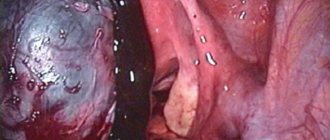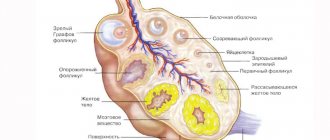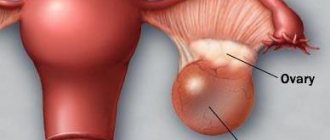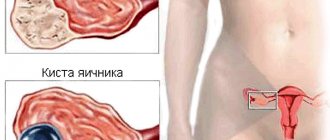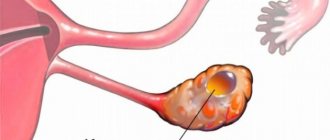What does a functional ovarian cyst mean?
Sometimes during ovulation, women may feel pain and discomfort in the lower abdomen. In this case, doctors suspect the development of a functional cyst of the left ovary. The process is associated with malfunctions in the reproductive system, as a result of which the follicle can stretch and fill with fluid if the egg leaves it or remains inside. This formation resolves on its own after several menstrual cycles. When the process creates discomfort, doctors prescribe treatment.
Follicular cyst
Follicular ovarian cysts are benign. They develop when the egg does not leave the follicle. The growth of formation occurs when fluid is released from nearby vessels carrying blood and lymph, or when secretion continues to be produced by granulosa-type epithelial cells. If the cyst is about 5 cm in size, it dissolves on its own, without the help of medications. Drug intervention requires a neoplasm that continues to grow up to 6 cm. There are cases when drugs do not have an effect and surgery must be performed.
Luteal cyst
A luteal functional cyst of the left ovary is formed after the release of the egg from the follicle and its transformation into the corpus luteum, which produces the hormones necessary for pregnancy. When conception does not occur, the endocrine gland disappears on its own after some time, and the cyst disperses along with it. However, there is a possibility that the corpus luteum will fill with fluid, which will then remain on the ovary. Such a cyst does not show itself with symptoms, and is often detected during routine examinations.
Prevention
Chorionic gonadotropin, which is administered by injection, can correct the situation. Once in the body, the hormone causes the follicle wall to rupture and thus release the egg. After treatment, all reproductive functions are completely restored.
No doctor can say for sure how long it will take until the unbursted follicle disappears. The duration of this process depends on the individual characteristics of the organism. Folic acid and multivitamins have a beneficial effect on the maturing follicle. But you can take these drugs only with the permission of your doctor. As studies have shown, deficiency of vitamins and folic acid can disrupt the ovulation process.
Severe stress, heavy physical activity and strict dietary restrictions can negatively affect the maturation of the follicle. Bad habits, such as smoking and alcoholism, can cause hormonal imbalance and therefore interfere with the normal release of the egg. Hormonal problems can occur due to taking certain medications.
Why does retention formation of the left ovary appear?
A retention cyst is a benign neoplasm that fills with water or blood. The reasons for its occurrence can be various factors, among which the most common are:
- disruptions in a woman’s endocrine system;
- abortions performed many times, resulting in consequences;
- excessively rapid rate of puberty;
- diseases arising in the endocrine system;
- hypothyroidism
Signs
A retention functional cyst of the left ovary may not manifest itself in any way, however, in some cases, when such a pathology occurs, the following symptoms may form:
- acute pain in the lower abdomen;
- feeling of pressure or heaviness in the pelvic area;
- irregular menstrual cycle;
- prolonged pain during menstruation;
- nausea that occurs after exercise;
- feeling of pressure when defecating or urinating;
- bloody vaginal discharge accompanied by pain.
There are symptoms that are more dangerous to a woman’s health; if they are detected, you should visit a doctor:
- temperature rise of more than 38 degrees;
- hair growth in areas characteristic of men;
- dizziness and general weakness;
- menstruation, characterized by heavy discharge;
- increase in abdominal volume;
- blood pressure readings that deviate from the norm;
- frequent need to drink;
- increased volume of urine when urinating;
- the presence of lumps in the abdominal cavity that can be palpated.
Articles on the topic
- Pain due to ovarian cysts in women: what to do
- Ovarian apoplexy - causes, diagnosis, forms and clinical recommendations
- Causes, signs and how to treat endometrioid ovarian cyst
Treatment of a functional cyst of the left ovary
Measures to get rid of cystic tumors come down to 2 options:
- conservative therapy;
- surgical intervention.
How to treat a corpus luteum cyst
If the retention formation does not disappear on its own within several menstrual cycles, it is treated with therapeutic methods, including:
- medicines;
- electrophoresis;
- magnetic therapy;
- ultraphonophoresis;
- laser therapy.
Medicines used for corpus luteum cyst are aimed at eliminating it, improving blood circulation, restoring hormonal balance and combating possible inflammatory processes. The following tablets have proven themselves well in this area:
- Tsvilin;
- Medvitsin;
- Livicin.
In addition, Duphaston can be used: it is a progesterone substitute. The main effect of the drug is aimed at reducing the size of the formation, however, it can be taken in the absence of the following contraindications:
- liver diseases;
- poor blood clotting;
- tumors of a malignant nature.
During the therapy period, the patient must avoid heavy physical activity and should also avoid sex for a while. Failure to comply with these rules may cause twisting of the pedicle of the FJ, which will negatively affect the progress of treatment. All this time, the woman must be under the supervision of a doctor, who after a couple of months should determine whether the therapy is helping. If the cyst continues to grow, a decision is made about the need for surgical intervention.
If the decision is positive, the patient undergoes laparoscopy. However, if bleeding occurs or the cyst is too large and may burst, the intervention method changes to laparotomy. These symptoms may indicate the need to completely remove the ovary. After surgery, in order to prevent relapses, a woman is recommended to carefully monitor her reproductive health, protect herself from stress overload, and try to prevent disruptions in the functioning of hormones.
Treatment of follicular ovarian cyst
Methods:
- Observation. Sometimes the neoplasm does not need to be treated, it goes away on its own, but the patient should be under constant supervision of doctors who will determine what the cyst looks like using ultrasound.
- Physiotherapy. This method of treatment helps to create conditions for the regression of cystic formation. Modern devices are capable of delivering medications to the required areas of the body painlessly and without injuring the digestive system (electrophoresis, ultraphonophoresis, magnetic therapy).
- Oxygen therapy. It is used when the patient experiences stress as a result of the periodic return of the disease. The method has a beneficial effect on brain activity, helping to reduce emotional stress.
- Hormonal and anti-inflammatory treatment. The method involves recommendations for taking oral contraceptives, anti-inflammatory drugs and vitamins.
- Homeopathic and traditional treatment. When the size of the cystic formation does not exceed 5 cm, it can resolve spontaneously. To support the body and to speed up the process, you can use homeopathic and folk remedies.
- Surgical intervention. Surgery will be required if PKJ cannot be cured with medications; it continues to grow. The intervention involves laparoscopy, removal or reduction of the size of the ovarian walls, and enucleation of the cyst.
Folk remedies
Herbal treatment is allowed only after the approval of a doctor, otherwise the risk of complications increases. Effective recipes:
- Sage. 1 tsp. brewed in a glass of water. Leave for 15 minutes. Drink 2 times a day for 7-12 days.
- Borovaya uterus. 1.5 tsp. brewed in a glass of boiling water. Leave for 10 minutes. Consume 3 tsp/day. Take 14 days, then stop for 2 weeks. After the break, drink again according to the same scheme for six months.
Follicular ovaries usually do not require treatment because they do not interfere with conception. However, if there is a question about the inability to get pregnant within six months or diseases of the pelvic organs have arisen, it is necessary to consult a doctor in time to eliminate the problem. By following preventive measures, you can avoid long-term treatment, infertility and other unpleasant consequences.
How is cystic formation treated?
To get rid of cystic formations of the left ovary, a complex of medications is used, which includes the following groups of drugs:
- hormonal (prescribed individually based on tests);
- anti-inflammatory (Ibuprofen, Voltaren);
- antimicrobial;
- immunostimulants (vitamins A and E, folic and ascorbic acid);
- sedatives (Notta, Novo-Passit, Valerian);
- folk remedies.
Is it possible to get pregnant with a functional cyst?
Many women are concerned about the question: is it possible to get pregnant with a follicular ovarian cyst? Experts say that with this disease, infertility may occur while the tumor is resolving. When only the left ovary is affected, the right one can release an egg that can be successfully fertilized conventionally or through IVF. Follicular cystosis and pregnancy are not uncommon today, but their proximity is an exception to the rule. In most cases, cystic formation begins to regress during fertilization.
Diagnostics
In most cases, women accidentally find out about an anomaly on an ultrasound of the pelvic organs; some are urgently hospitalized due to complications. If a representative of the fairer sex regularly visits a gynecologist, the cyst becomes known when the pathology does not exceed the permissible size.
It is not difficult for an experienced obstetrician-gynecologist to feel a neoplasm during an examination on a chair - by palpating, a smooth, elastic cyst with thin walls is felt, and there is no pain when pressing on the small formation. To confirm the diagnosis, the doctor sends the patient for an ultrasound examination. Doppler ultrasound determines the location, parameters, and stage of the pathology.
The most effective diagnostic method is laparoscopic examination, during which, if necessary, surgical treatment can be performed immediately.



